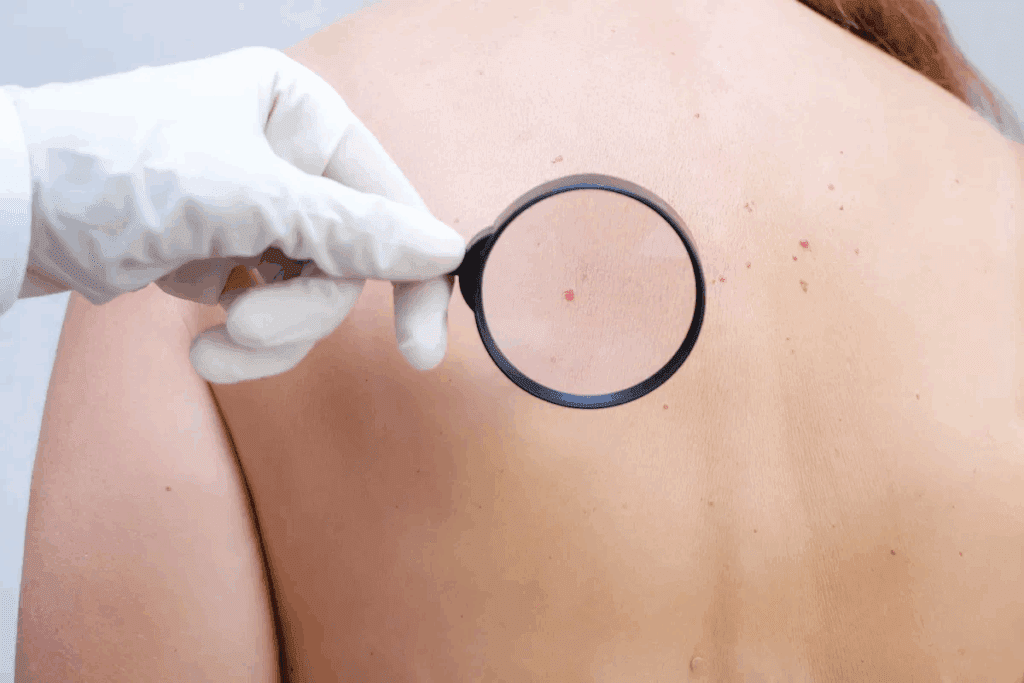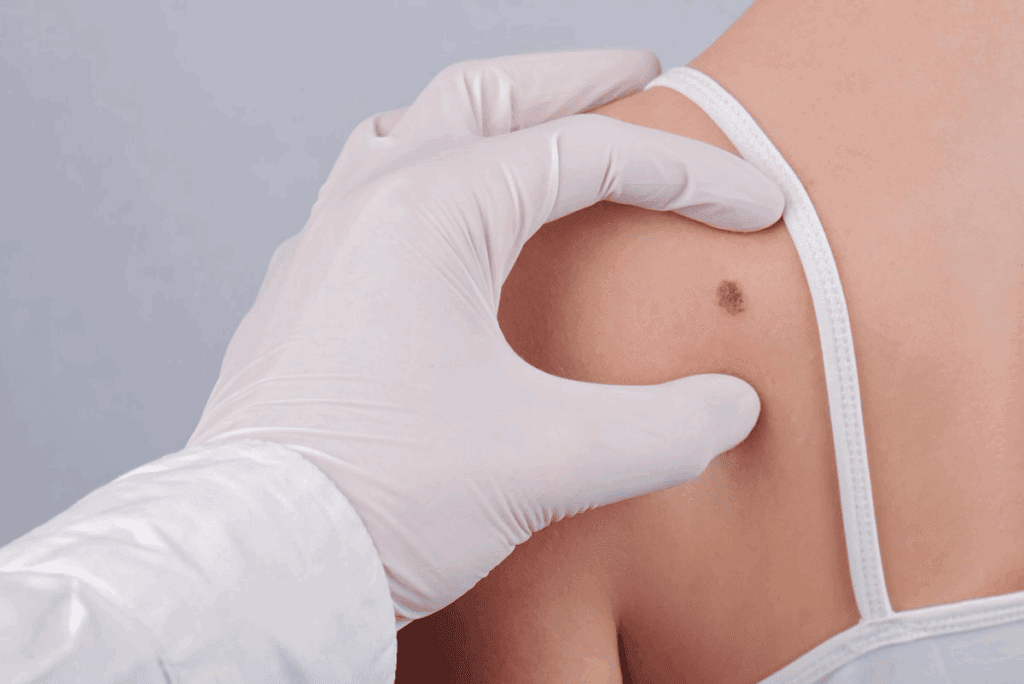Last Updated on November 27, 2025 by Ugurkan Demir

Skin cancer is one of the most common cancers worldwide. It’s getting more common everywhere. The American Cancer Society says about 5.4 million basal and squamous cell skin cancers are found each year in the U.S.
We will look at the seven main types of . We’ll also explain how to spot warning signs. Knowing the different types is key for catching it early and treating it well.
At Liv Hospital, we offer reliable, patient-focused skin care. We use proven methods to find skin cancer early. This helps you understand the risks and signs of different skin cancer types.

Skin cancer is a big worry in America. It’s one of the most common cancers and a big threat to our health. We see more cases every year, so it’s key to know the stats and how to catch it early.
About 5.4 million people get basal and squamous cell skin cancers every year in the U.S. This number shows how common it is. Skin cancer affects many people and is getting more common. It’s a big worry for public health.
Knowing how common it is helps us fight it better. Skin cancer isn’t just one disease. It has different types, each with its own risks.
The survival rates for skin cancer depend on when it’s found. For example, catching melanoma early means a 99 percent chance of survival. This shows how vital early detection is.
Finding skin cancer early makes treatment work better. We need to check our skin often and know the signs. Early detection can save lives and improve treatment results.
In short, skin cancer is a big worry in America. We need to understand it, its stats, and why catching it early is so important. By staying informed and active, we can fight skin cancer together.

Basal cell carcinoma is the most common skin cancer. It’s important to know about it for early detection. This type of cancer grows slowly and rarely spreads.
Basal cell carcinoma looks like a small, shiny bump or a pink patch. It can also be a flat, flesh-colored or brown scar-like lesion. Early detection is key for effective treatment. Watch for new or changing growths, mainly in sun-exposed areas.
The signs can vary, but common ones include a transparent or pearly look, bleeding or crusting, and a sore that won’t heal. It’s important to notice these signs and see a dermatologist if you’re worried.
Basal cell carcinoma often shows up on sun-exposed areas like the face, scalp, ears, and neck. The face, including the nose, eyelids, and forehead, is very common. A light pink spot on the scalp can be an early sign.
These areas get more UV radiation, raising the risk of basal cell carcinoma. We need to protect these areas from the sun and watch for any suspicious changes.
The good news is that basal cell carcinoma is highly treatable if caught early. Treatment depends on the tumor’s size, location, and depth, and the patient’s health. Common treatments are surgical excision, Mohs surgery, and topical creams.
The outlook for basal cell carcinoma is very good, with a high cure rate if treated quickly. We stress the importance of regular skin checks and sun protection to prevent recurrence and lower the risk of other skin cancers.
It’s important to know about squamous cell carcinoma for early detection and treatment. This type of skin cancer is common and often shows up on sun-exposed areas. People who spend a lot of time outside should be careful.
Squamous cell carcinomas look like pink or red bumps or patches that don’t heal. On lighter skin, these spots are easy to see. But on darker skin, they might look like dark patches. Knowing this helps catch them early.
This type of skin cancer often shows up on sun-exposed areas like the face, scalp, arms, and back. These spots get more sun damage, raising the risk of skin cancer.
Things like too much sun, sunburns, and a weak immune system can lead to squamous cell carcinoma. To prevent it, use sunscreen, wear protective clothes, and stay in the shade when it’s sunny.
| Risk Factor | Description | Prevention Strategy |
| Prolonged Sun Exposure | Increases risk due to UV damage | Use broad-spectrum sunscreen, wear protective clothing |
| History of Sunburns | Indicates skin damage from UV radiation | Avoid sunburns by seeking shade and wearing protective gear |
| Weakened Immune System | Reduces body’s ability to fight cancer cells | Maintain overall health, consult with healthcare provider about immune system health |
Knowing the risks and taking steps to prevent them can lower your chance of getting squamous cell carcinoma. Regular skin checks and visits to the dermatologist are key for catching and treating it early.
It’s important to know about melanoma to spot its signs early. Melanoma is the most dangerous skin cancer because it grows fast and can spread.
The ABCDE rule helps us spot melanoma early. It stands for Asymmetry, Border irregularity, Color variation, Diameter increase, and Evolving shape or size.
Melanoma comes in different types, each with its own look. The four main types are:
Melanoma can show up as dark spots or moles that change. Look out for new moles or changes in existing ones, like itching, bleeding, or oozing.
Melanoma on the scalp is tricky because it can hide. It’s important to check your scalp often, if you’ve been in the sun a lot or have a family history of melanoma.
Knowing these signs and acting early can help us catch and treat melanoma better.
Merkel Cell Carcinoma is a rare and aggressive skin cancer. It mainly affects people over 70 and men more than women. Knowing about it is key for health.
Merkel cell carcinoma shows up as a painless lump. These lumps can be red, purple, or the same color as your skin. They grow fast. Spotting new or changing lumps early is very important.
This cancer often shows up on sun-exposed areas like the face, neck, and arms. It can also appear on other parts of the body, like the back. Its growth is quick, so seeing a doctor fast is vital.
| Common Locations | Growth Pattern |
| Face, Neck, Arms | Rapid growth |
| Back, Other areas | Variable, but often aggressive |
Several things can raise your risk of getting Merkel cell carcinoma. These include a lot of sun exposure, fair skin, and a weak immune system. Catching it early is key for treatment success. Spotting signs early and getting medical help quickly can make a big difference.
Key Risk Factors:
By knowing these risks and watching for skin changes, you can help find and treat it early.
Skin cancer can show up in many ways and places on our bodies. Knowing what it looks like on different parts can help us catch it early. This knowledge is key to getting the right treatment.
The face and scalp are common spots for skin cancer, mainly for those who spend a lot of time in the sun. Basl cell carcinoma and squamous cell carcinoma often appear here. Spotting skin cancer in these areas is important to tell the difference between harmless and dangerous growths.
Skin cancer can also show up on fingers and other parts of the body. For example, melanoma on fingers might look like a dark spot or streak under the nail. Catching these signs early is very important for treatment success.
| Type of Skin Cancer | Common Locations | Visual Characteristics |
| Melanoma | Fingers, under the nail | Dark spot or streak |
| Squamous Cell Carcinoma | Back of hands, arms | Rough, scaly patch or open sore |
| Basal Cell Carcinoma | Arms, shoulders | Shiny bump or pink patch |
The stomach and back are also places where skin cancer can occur, often because of sun exposure. It’s important to watch these areas for any unusual changes, like new moles or changes in existing ones.
Early skin cancer can look different on different skin tones. It might look like a new growth, a sore that doesn’t heal, or a mole that changes. Knowing these signs can help us get medical help quickly.
By learning what skin cancer looks like on different parts of the body, we can catch it early. Regular self-checks and visits to the dermatologist are key to keeping our skin healthy.
Dermatofibrosarcoma protuberans is a rare skin cancer known for its slow growth. It often looks like a firm, painless nodule. This makes it hard to spot early.
This skin cancer starts as a small, firm nodule. It can be flesh-colored or slightly darker. It’s hard to tell apart from other skin growths because of this.
Dermatofibrosarcoma protuberans grows slowly. It starts small and gets bigger over time. Spotting it early is key to treating it on time.
| Characteristics | Description |
| Appearance | Firm, painless nodule; flesh-colored or slightly pigmented |
| Growth Pattern | Slow-growing; can be mistaken for a scar or benign tumor |
| Common Locations | Typically on the trunk, arms, or legs; can occur on the face or scalp |
Figuring out if you have dermatofibrosarcoma protuberans can be tough. It looks like other skin issues. A biopsy is needed to confirm it. Treatment usually means surgery to remove the tumor.
Early action is key to beating dermatofibrosarcoma protuberans. Knowing what it looks like helps catch it early. This makes treatment more effective.
Sebaceous carcinoma is a rare and aggressive skin cancer. It starts in the skin’s oil glands. This cancer is rare and can be hard to diagnose because it looks like other skin issues.
Sebaceous carcinoma shows up as a firm, painless lump. It often appears on the eyelids but can also be found on the face and scalp. The identifying features include a slow-growing, yellowish or flesh-colored lesion that may bleed or ulcerate. It’s important to spot these signs early for better treatment.
It usually shows up on the eyelids, eyebrows, nose, and other areas with many oil glands. Knowing where it often appears helps people watch their skin more closely.
The exact cause of sebaceous carcinoma is not known. But some risk factors have been found. These include radiation therapy, certain genetic conditions, and too much sun exposure. Knowing these risks helps in preventing it.
Prevention mainly means protecting the skin from too much sun and watching for skin changes, mainly in high-risk areas. Regular self-checks and doctor visits can catch it early.
Learning about sebaceous carcinoma helps people protect their skin. This reduces the risk of this serious skin cancer.
Regular skin checks can save your life. By taking care of your skin, you can spot problems early. The American Academy of Dermatology suggests doing skin self-exams every month.
Doing a self-exam is easy and can be done at home. Here’s how to do it:
Technology has made it easier to keep an eye on your skin. There are apps and devices that help track skin changes. These tools are great for catching problems early.
| Technology | Description | Benefits |
| Skin tracking apps | Apps that allow you to upload photos of your moles and skin lesions | Helps in monitoring changes over time |
| Dermatology AI tools | Artificial intelligence-powered tools that analyze skin images | Provides preliminary assessments and recommendations |
If you notice anything unusual, see a dermatologist. Look for the ABCDE signs of melanoma: Asymmetry, Border irregularity, Color variation, Diameter increase, and Evolving shape or size. Also, if you have a family history of skin cancer or have had it before, get regular check-ups.
By doing self-exams and seeing a dermatologist, you can keep your skin healthy. Early detection is key to effective treatment. Being proactive about your skin health can save your life.
It’s important to know about the different types of skin cancer and their warning signs. This knowledge helps with early detection and treatment. Taking steps like regular skin checks and protecting against UV radiation can help you control your skin health.
Early detection and prevention are vital for better treatment outcomes. We urge people to watch for any unusual skin changes and see a doctor if they find something suspicious. This can greatly improve treatment success and keep your skin healthy.
By focusing on prevention and early detection, we can all help lower the risk of skin cancer. This way, we can promote healthy skin for everyone.
The most common types of skin cancer are basal cell carcinoma, squamous cell carcinoma, and melanoma. Basal cell carcinoma is the most common, making up most cases.
Skin cancer on the face can look like a new or changing growth. It might be a sore that doesn’t heal or a spot that bleeds or oozes. Basal cell carcinoma looks like a small, shiny bump. Squamous cell carcinoma is a firm, red nodule.
Look for new or changing spots, sores that don’t heal, or areas that are bleeding or oozing. Check for unusual moles or growths. If you notice anything suspicious, see a dermatologist.
Melanoma on the scalp can be hidden. It’s important to check this area regularly. Look for a new or changing mole, a sore that doesn’t heal, or a spot that is bleeding or oozing. Use a mirror or ask someone to help you check your scalp.
Early-stage skin cancer can look like a small, new, or changing growth. It might be a sore that doesn’t heal or a spot that is bleeding or oozing. It’s often small and may not be painful. It’s important to be vigilant and see a dermatologist if you notice anything suspicious.
To perform a self-examination, check your skin from head to toe. Use a mirror to see areas that are hard to visualize. Look for new or changing spots, sores that don’t heal, or areas that are bleeding or oozing. Use a systematic approach to ensure you check all areas of your skin.
Risk factors for Merkel cell carcinoma include fair skin, a history of sun exposure, and a weakened immune system. Older adults are also more likely to develop this type of skin cancer.
Yes, there are various technologies available to help monitor your skin for cancer. This includes apps and devices that can track changes in your skin over time. Consult with a dermatologist to determine the best approach for your individual needs.
Consult a dermatologist if you notice a new or changing spot, a sore that doesn’t heal, or an area that is bleeding or oozing. It’s also a good idea to schedule regular check-ups with a dermatologist, if you have a history of skin cancer or are at high risk.
Treatment options for sebaceous carcinoma typically involve surgical removal of the tumor. It may also include additional therapies such as radiation or chemotherapy. Consult with a dermatologist or oncologist to determine the best course of treatment.
National Center for Biotechnology Information. (2025). 7 Types of Skin Cancer Pictures Spots. Retrieved from https://www.ncbi.nlm.nih.gov/books/NBK441949/
Subscribe to our e-newsletter to stay informed about the latest innovations in the world of health and exclusive offers!